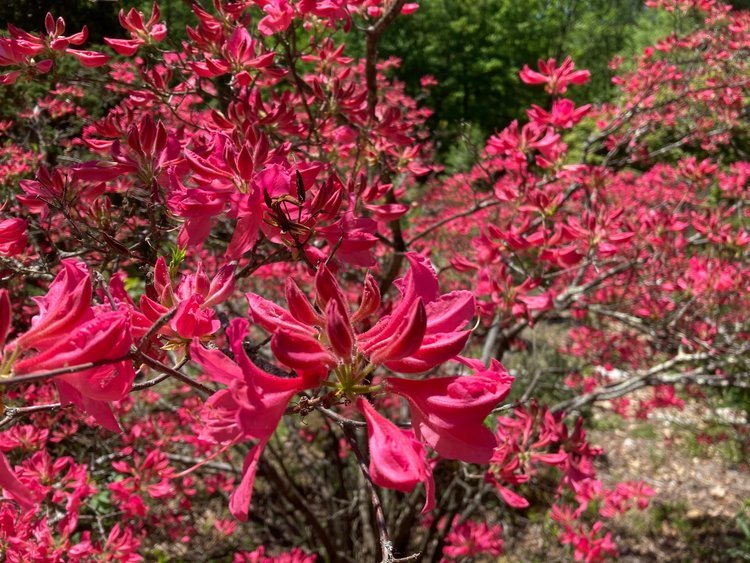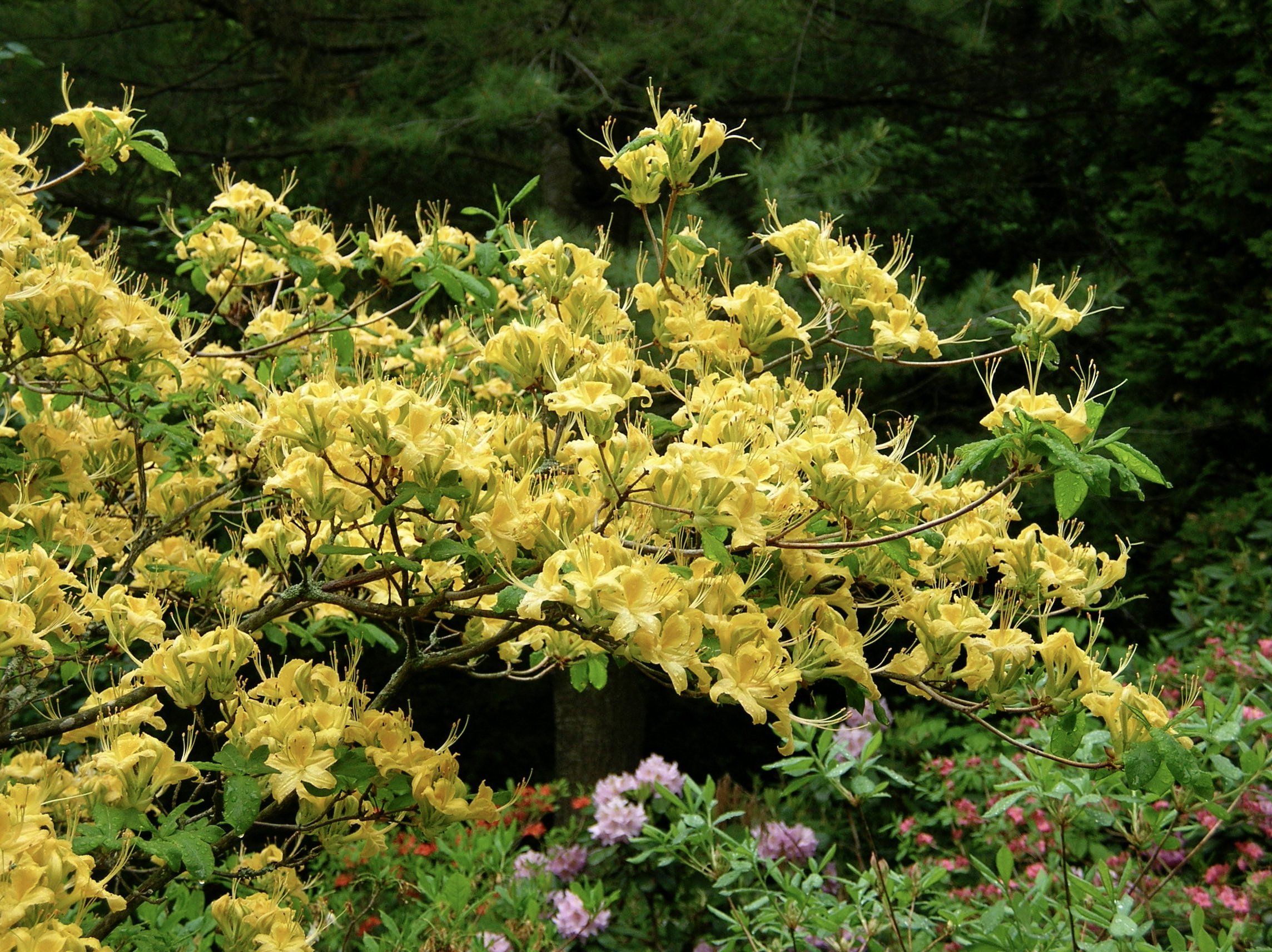The term Deciduous Azalea is used here to describe those members of the genus Rhododendron that have five stamens (male flower part) and loose their leaves in the winter. The vast majority in this group are native to North America - about 15 species - and are among the most cherished and beautiful of our native shrubs. Found from Florida into southern Canada, these are not to be confused with their Asian cousins, the evergreen Azaleas, which so typify the spring landscapes of a wide swath of the more temperate parts of the US. There are three species native to Vermont, but several of the more southern natives are hardy here as well.
A multitude of hybrid deciduous azaleas have bean bred over the last 200+ years, beginning in Ghent, Belgium in the early 1800’s when native North American species were introduced and crossed with one another by a baker named M. Mortier, to produce the first hybrids. Other plant breeders across the continent followed and by 1850 there were more than 500 named varieties in cultivation. Over time, 100’s more have been produced in Europe, Asia and North America till present, but the vast majority of these are not rated cold hardy enough for our climate. Closer to home, around the middle of the 20th century, Frank Abbott of Bellows falls Vermont, developed several cold hardy varieties able to withstand -25F or colder. He, along with the Mezzit’s of Weston Nursery in Hopkinton, MA and other breeders, have developed many cold hardy, beautiful hybrids that you will see here at Lincoln Hill Botanical Garden.
Paul Wieczoreck and a 50 year old Flame Azalea-
Rhododendron calendulaceum

Rhododendron arborescens "Sweet Azalea" Late June. A very fragrant Appalachian Mtountans native.

Rhododendron arborescens "Sweet Azalea". Close up of flowers. Entirely cold hardy in Zone 4.
Rhododendron calendulaceum "Flame Azalea" Mid to late June. Known as "Sky Paint Flower" by the Cherokee People; native to the Appalachian Mountains from West Virginia to Georgia

Rhododendron calendulaceum "Flame Azalea", this species is pollinated by Swallow Tail Butterflies. While they are feeding on nectar , their wings collect sticky pollen from the noticeably long anthers and deposit it on the next flower's receptive stigma (female flower part).

Rhododendron 'Rainbow'. Weston Nursery's fantastic "Flame Azalea" selection

Rhododendron 'Rainbow'

Rhododendron calendulaceum 'Flame Azalea' Gold flowered form.

Rhododendron calendulaceum 'Flame Azalea' Close up of Flowers. Perfectly hardy in Zone 4

Rhododendron 'Deep Rose' - A hybrid between two eastern North American species, "Flame Azalea" and "Pinxterbloom" Azalea by Weston Nursery, Hopkinton, MA.

Rhododendron 'Deep Rose' Close up of flower

Rhododendron July Jester'. A David Leach Hybrid blooming mid July

Rhododendron 'July Jester', close up of flower.

Rhododendron 'Golden Showers', blooms second week of July. Fragrant.

Rhododendron 'Popsicle' - blooming with Astilbe in early July.

Rhododendron japonicum "Japanese Azalea". Often used as a parent in crosses with North American species instilling larger flowers in its progeny.

Rhododendron 'Jane Abbott'. Hybridized by Vermonter Frank Abbott more than 75 years ago from a cross between the VT native "Mountain Pink", Rhododendron prinophyllum, and the "Japanese Azalea", Rhododendron japonicum. Very fragrant and floriferous!

Rhododendron schlippenbachii "Royal Azalea". A Japanese native blooming in late May. Flowers can be 3" across! Hardy to about -15F so not reliably hardy here.

Rhododendron 'Late Date'. Early August- one of the last Azaleas to bloom here.

Rhododendron 'July Jester' close up.

Rhododendron 'Deep Rose' - close up of flower.

Rhododendron 'Northern Hi-Lights. One of the "Northern Lights" series developed for exceptional cold hardiness at the University of Minnesota. Unfortunately, like some others in this series, is very susceptible to Azalea Saw-fly larvae damage.

Rhododendron vaseyi - "Pinkshell Azalea" Endemic to only a few counties in North Carolina high in the appalachian Mountains, between 4,000 to 6,000ft in elevation. Perfectly hardy in zone 4 and has never failed to bloom here in over 30years. Blooming on the early side - mid to late May.

Rhododendron vasyei - "Pinkshell Azalea" Close up of flowers

Rhododendron 'Narcissiflora' - an old Ghent Hybrid from Belgium hybridized sometime in the 1860's. Stamens are replaced by petals resulting in a "double" flower form with twice the normal number of petals. Fragrant.

An un-registered Azalea hybridized and raised from seed here at Lincoln Hill Nursery

Rhododendron prinophyllum - "Roseshell Azalea" or "Mountain Pink". Native from Vermont all the way to the Smokey Mountains, NC. Clove scented flowers and our most cold hardy Azalea ; to zone 3. One of the parents of many cold hardy varieties. Exceptional native plant!

Rhododendron prinophyllum - plants can reach over 8' tall. photo taken at The Fells, near Lake Sunapee, NH.

Rhododendron prinopyhllum - "Mountain Pink"- close up of the deliciously fragrant flower.

Rhododendron calendulaceum - Flame Azalea Earlier blooming gold form.

Rhododendron calendulaceum - "Flame Azalea" - earlier blooming gold form

Rhododendron hybrid - bred at Lincoln Hill Nursery ; blooms beginning of June

Rhododendron hybrid - bred at Lincoln Hill Nursery; blooms beginning of June.

Rhododendron 'Parade'. A Weston Nursery summer blooming hybrid. Mid July.

Rhododendron 'Blanch Edebohl' - Named and registered by Paul Wieczoreck with the American Rhododendron Society after the wife of deciduous azalea grower Louis Edebohl of Hardwick, VT.

